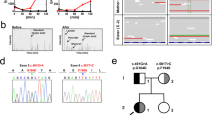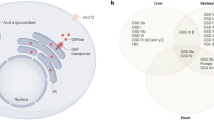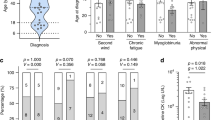Abstract
Glycogen storage disease type 1a (von Gierke disease, GSD-1A) is caused by the deficiency of microsomal glucose-6-phosphatase (G6Pase) activity which catalyzes the final common step of glycogenolysis and gluconeogenesis. The cloning of the G6Pase cDNA and characterization of the human G6Pase gene enabled the identification of the mutations causing GSD-1a. This, in turn, allows the development of non-invasive DNA-based diagnosis that provides reliable carrier testing and prenatal diagnosis. Here we report on two new mutations E110Q and D38V causing GSD-1a in two Hungarian patients. The analyses of these mutations by site-directed mutagenesis followed by transient expression assays demonstrated that E110Q retains 17% of G6Pase enzymatic activity while the D38V abolishes the enzymatic activity. The patient with the E110Q has G222R as his other mutation. G222R was also shown to preserve about 4% of the G6Pase enzymatic activity. Nevertheless, the patient presented with the classical severe symptomatology of the GSD-1a.
Similar content being viewed by others
Introduction
Glycogen storage disease type 1a (von Gierke disease, GSD1a), one of the most common types of glycogen storage diseases, is caused by the deficiency of microsomal glucose-6-phosphatase (G6Pase) activity, which catalyzes the final common step of glycogenolysis and gluconeogenesis. The enzyme is normally expressed in the liver, kidney and intestinal mucosa and its absence is associated with excessive accumulation of glycogen in these organs. GSD-1a is transmitted as an autosomal recessive trait with an estimated overall frequency of 1:100,000. The disease manifests itself during the early years of life with hepatomegaly, severe fasting hypoglycemia, bleeding diathesis, lactic acidemia, hyperlipidemia and hyperuricemia. Growth retardation and delayed sexual maturation become prominent during the second decade of life. Long-term complications include gout, hepatic adenomas, osteoporosis and renal disease [1–3]. Currently, the diagnosis of GSD-1a is established by demonstrating the lack of G6Pase activity on a liver biopsy specimen. Carrier testing and prenatal diagnosis on the basis of enzyme activity are not possible. The cloning of the G6Pase cDNA and characterization of the human G6Pase gene by Lei et al. [4] enabled the characterization of the mutations causing GSD-1a [4–9]. This, in turn, allowed the development of non-invasive DNA-based diagnosis that provides reliable carrier testing and prenatal diagnosis.
The identification of the mutations causing GSD-1a provides an insight into the structure-function relation of G6Pase catalysis by revealing the structural roles of specific amino acids. Here we report on two new mutations causing GSD-1a in two Hungarian patients and the analysis of these mutations on their effect on the G6Pase activity by site-directed mutagenesis followed by transient expression assays.
Patients
D.O., male, was born on April 21, 1990 after 37 weeks gestation as a second child to non-consanguineous Hungarian parents. The first child is healthy. At age 5 months, he started to suffer from episodes of restlessness and vomiting during the early morning hours. On hospital admission at 7 months of age because of Escherichia coli and Rotavirus gastroenteritis an extreme hepatomegaly was found. Blood biochemistry revealed fasting hypoglycemia, metabolic acidosis, hyperlactic acidemia, hypertriglyceridemia and hypercholesterolemia. G6Pase activity performed on fresh liver biopsy material according to Hers [10] showed zero activity. The infant was started on dietary treatment with frequent meals, restriciton of glucose and lactose, two meals with uncooked starch during the night and xanthine oxidase inhibitor to treat hyperuricemia. At present he has no psychomotor retardation and his physical growth is between the 3rd and 10th percentile.
P.D. was born on October 9, 1987 after 42 weeks of gestation to non-consanguineous Hungarian parents and has a younger healthy brother. He was admitted to hospital at 2 months of age because of diarrhea and restlessness. On admission, hepatomegaly, fasting hypoglycemia and metabolic acidosis were noted. Blood biochemistry showed hyperlipoproteinemia and hyperuricemia. A fasting glucagon test resulted in a flat blood glucose curve. Liver biopsy revealed G6Pase activity of 0.5 nmol/min/mg tissue, measured according to Hers [10] at a glucose-6-phosphate (G6P) concentration of 100 mM, after subtraction of nonspecific phosphatase activities. As control values range between 4 and 6 nmol/min/mg tissue, the patient’s activity represents about 10% of normal activity. As of 1995, he was treated by frequent meals exclusive of lactose and fructose and nocturnal gastric drip which had a beneficial effect on his physical growth (8.5 cm/year) and improved his abnormal lipoprotein values.
Methods
Extraction of DNA, polymerase chain reaction (PCR) amplification, single-stranded conformation polymorphism (SSCP) was performed as described elsewhere [8] except for the SSCP of the D38V that was observed only under the conditions of electrophoresis on 0.75 × MDE gel, in 0.6 × TBE at 4° C, 8 W for 16 h. Sequence analysis was performed on the whole PCR product purified by the GeneClean kit (BIO101, Calif., USA) by the SequiTherm Cycle Sequencing kit (Epicentre Technologies, Wisc., USA) and was confirmed on two independent PCR products on both strands.
The E110Q and mutations were introduced into the G6Pase cDNA by site-directed mutagenesis as described in Lei et al. [6], by use of the phGpase-1 cDNA which retains the primary amino acid sequence (nucleotides 77–1,156) and activity of wild-type G6Pase. Constructs were transfected into COS 1 cells as described in Lei et al. [6]. Northern hybridization analysis of G6Pase transcripts from transfected cells showed that WT, D38V and E110Q mutant G6Pase were expressed at similar levels. Transfection efficiency varies from experiment to experiment as efficiency is affected by many factors, including cell passage numbers, culture conditions, media, serum, etc. However, within each experiment, the transfection efficiency of the various plasmids differs very little as monitored by Northern blot analysis for G6Pase mRNA expression. Therefore for each transfection experiment, the wild type and vector alone (mock) controls were included. The mutated and the wild-type constructs were tested for enzymatic activity after transient expression in COS-1 cells.
Phosphohydrolase activity was determined essentially as described by by Burchel et al. [11] and detailed in Lei et al. [6]. reaction mixtures (100 µl) contained 50 mM cacodylate buffer pH 6.5, 2 mM EDTA, the G6P concentrations specified (0.5, 1 or 10 mM) and appropriate amounts of cell homogenates were incubated at 30° C for 10 min. Protein determination was done using the Micro BCA protein assay of Pierce (Rockford, Ill., USA). Sample absorbance was determined at 820 nm and is related to the amount of phosphate released using standard curve constructed by a stock of inorganic phosphate.
Results
Identification of the Mutations in the G6Pase Gene
The five exons of the G6Pase gene were amplified separately and subjected to SSCP analysis to verify the site of the mutations. Patient P.D. showed abnormal heterozygote SSCP patterns in exons 2 and 5. The SSCP of the normal allele and a PCR product with a deviated mobility that was different from the R83C pattern (fig. 1). Sequencing the PCR product of exon 2 of P.D. revealed a G to C transversion in position 407 in addition to the normal sequence (fig. 2). This will result in the replacement of the glutamic acid at position 110 by glutamine. The deviant pattern in the fifth exon (not shown) was caused by a to G to C transversion at position 743 causing G222R (not shown), a mutation reported before [4]. Patient D.O. showed heterozygous SSCP patterns in the first and second exons. The abnormal SSCP pattern of exon 1 was inherited from his father (fig. 3). The SSCP pattern in his second exon was that of the R83C mutation also found in his mother (not shown), this SSCP finding was confirmed by sequencing (not shown). The abnormal SSCP pattern of exon 1 was found by sequencing to result from an A to T transversion at position 192 (fig. 4). This will cause replacement of the aspartic acid at codon 38 by valine.
Effects of the Mutations on the G6Pase Phosphohydrolase Activity
In order to confirm that these codon changes cause GSD-1a they were introduced into the G6Pase cDNA by site-directed mutagenesis and the enzymatic activity of the mutated construct was compared to that of the wild-type construct after transient expression in COS-1 cells (table 1). The change of the aspartic acid at codon 38 by valine completely abolishes the enzymatic activity while the replacement of the glutamic acid by glutamine leaves 17% of the enzymatic activity. To verify whether the replacement of glutamic acid by glutamine affects Km or Vmax, G6Pase activitiy of the mutant was also tested at 1 and 0.5 mM (similar to the physiologic value) G6P, the same ratio of activity of E110Q construct to the wild type construct was preserved (table 1).
Discussion
GSD-1a is a severe metabolic disease involving carbohydrate, purine and lipid metabolism. The severeity of the disease, the need of performing liver biopsies for diagnosis and the inability to establish prenatal diagnosis make the identification of the mutations clinically important. The identification of the mutations causing GSD-1a enables the families to benefit from DNA-based analysis for the detection of heterozygotes and prenatal diagnosis that can be made from blood, chorionic villus cells or amniocytes. The distinct SSCP patterns of both E110Q and V116G mutations enable easy detection of affected individuals and heterozygotes. Indeed, prenatal diagnosis using SSCP analysis was successfully employed in several GSD-1a families [10]. Successfully identifying most mutations responsible for GSD-1A in a population would mean that those patients in whom GSD-1a was suspected could be screened for the mutations prevalent in the population to avoid the liver biopsy. Hungarians are shown here to have two of the common mutations reported in other populations (R83C and G222R) as well as different mutations, demonstrating the need to characterize the mutations for each population in order to be able to benefit from DNA-based diagnosis.
Patient P.D. has two mutations that retain about 4–17% of enzymatic activity; nevertheless, he presented with the classical severe symptoms of GSD-1A. Thus, apparently a higher activity of the enzyme is necessary for maintaining adequate rates of glycogenolyis and gluco-neogenesis. The presentation of GSD-1a is modified by many factors in addition to G6Pase activity, including the frequency of feeds, intercurrent infections as well as hepatic glucose production by alternative pathways, thus in contrast with many other inborn errors, the small residual enzyme activity may not make a big difference to the clinical problem.
Structure Function Requirements of the Human G6Pase
The replacement of the negatively charged glutamic acid at codon 110 by the uncharged polar glutamine leaves 17% of enzymatic activity, which appears to affect the Vmax. Codon 110 is situated in the lumen side between the arginine at codon 83 and the histidine at 119. The arginine at position 83 was suggested to be involved in the positioning of the phosphate which binds the histidine at position 119 that acts as the acceptor [11]. The E110Q mutation demonstrates the requirement of keeping the electrical charges in this domain as the size of glutamic acid would be similar to that of glutamine.
The aspartic acid at codon 38 is localized in the first putative transmembrane domain. Our report is the first to identify a mutation in this domain. The replacement of the negative charge of aspartic acid with the nonpolar valine is not compatible with enzymatic activity (table 1), thus suggesting an important role for the negative charge in the conformation of the transmembrane domain, that could depend on the neutralization of the positive charge of the arginine at codon 40, the single basic amino acid in this transmembrane domain. In addition, the aspartic acid may function in the trafficking and docking of the enzyme in the membrane. The integrity of the transmembrane domains for enzyme catalysis appears to be important for the G6Pase enzymatic activity since three mutations affecting the third, fourth and sixth transmembrane domains were already reported to abolish completely or greatly reduce th G6Pase enzymatic activity (V166G [8], Lei et al., unpublished; G222R [4] and ΔF327 [5], respectively). The importance of the transmembrane domains could be explained by their function in the tight association of G6Pase with the G6P transport. It was recently demonstrated that in G6Pase knockout mice both G6Pase activity and G6P transport are destroyed [12], thus providing direct evidence for the tight coupling between G6Pase activity and G6P transport which had previously been inferred from kinetic studies of G6Pase catalysis [13]. In addition, the transmembrane domains probably have a role in the strong association of the G6Pase with the endoplasmic reticulum membrane [14].
References
Chen Y-T, Coleman RA, Scheinman JL, Kolbeck PC, Sidbury JB: Renal disease in type 1 glycogen storage disease. N Engl J Med 1988; 318:7–11.
Beaudet AL: The glycogen storage diseases; in Wilson JD, Braunwald E, Isselbacher KJ, Petersdorf RG, Martin JB, Fauci AS, Root RK (eds): Harrison’s Principles of Internal Medicine, ed 12. New York, McGraw-Hill, 1991, pp 1854–1860.
Chen Y-T, Burchell A: Glycogen storage diseases; in Scriver CR, Beaudet AL, Sly WS, Vale D (eds): The metabolic basis of inherited diseases, ed 7. New York, McGraw-Hill, 1995, pp 925–965.
Lei K-J, Shelly LL, Pan C-J, Sidbury JB, Chou JY: Mutations in the glucose-6-phosphatase gene that cause glycogen storage disease type la. Science 1993;262:580–583.
Lei K-J, Pan C-J, Shelly LL, Liu J-L, Chou JY: Identification of mutations in the gene for glucose-6-phosphatase the enzyme deficient in glycogen storage disease type 1a. J Clin Invest 1994;93:1994–1999.
Lei K-J, Shelly LL, Lin B, Sidbury JB, Chen Y-T, Nordlie RC, Chou J: Mutations in the glucose-6-phosphatase gene are associated with glycogen storage disease type 1a and 1aSP but not 1b and 1c. J Clin Invest 1995;95:234–240.
Lei K-J, Chen Y-T, Chen H, Wong L-Jc, Liu J-L, Mcconkie-Rosell A, Van Hove JLK, Ou HC-Y, Yeh NJ, Pan C-J, Chou JY: Genetic basis of glycogen storage disease type 1a: Prevalent mutations at the glucose-6-phosphatase locus. Am J Hum Genet 1995;57:766–771.
Parvari R, Moses S, Hershkovitz E, Carmi R, Bashan N: Characterization of the mutations in the glucose-6-phosphatase gene in Israeli patients with glycogen storage disease type 1a: R83C in six Jewish and a novel V166G mutation in a Muslim Arab. J Inher Metab Dis 1995;18:21–27.
Hwu W-L, Chuang S-C, Tsai L-P, Chang M-H, Chuang S-M, Wang T-R: Glucose-6-phospha-tase gene G327A mutation is common in Chinese patients with glycogen storage disease type la. Hum Mol Genet 1995;4:1095–1096.
Hers HG: Glycogen storage diseases. Adv Metab Dis 1964;1:1–44.
Burchell A, Hume R, Burchell B: A new microtechnique for the analysis of human hepatic microsomal glucose-6-phosphate system. Clin Chim Acta 1988;173:183–192.
Parvari R, Hershkovitz E, Carmi R, Moses S: Prenatal diagnosis of glycogen storage disease type 1a by single stranded conformation polymorphism. Prenat Diagn 1996;16:862–865.
Lei K-J, Pan C-J, Liu J-L, Shelly LL, Chou JY: Structure-function analysis of human glucose-6-phosphatase, the enzyme deficient in glycogen storage disease type la. J Biol Chem 1995; 20:11882–11886.
Lei K-J, Chen H, Pan C-J, Ward JM, Mosinger B Jr, Lee EJ, Westphal H, Mansfield BC, Chou JY: Glucose-6-phosphatase dependent substrate transport in the glycogen storage disease type-1a mouse. Nat Genet 1996;13:203–209.
St-Denis J-F, Breteloot A, Vidal H, Annabi B, van de Werve G: Glucose transport and glucose-6-phosphate hydrolysis in intact rat liver microsomes. J Biol Chem 1995;270:21092–21097.
Nordlie RC, Sukalski KA: Multifunctional glucose-6-phosphatase: A critical review; in Martonosi AN (ed): The Enzymes of Biological Membranes. New York, Plenum Press, 1985, pp 349–398.
Acknowledgments
This work was supported in part by a donation of Herman Silver for the study of metabolic genetic diseases. The authors thank Mrs. Magda Bartal for her excellent technical assistance.
Author information
Authors and Affiliations
Corresponding author
Rights and permissions
About this article
Cite this article
Parvari, R., Lei, KJ., Szonyi, L. et al. Two New Mutations in the Glucose-6-Phosphatase Gene Cause Glycogen Storage Disease in Hungarian Patients. Eur J Hum Genet 5, 191–195 (1997). https://doi.org/10.1007/BF03405916
Received:
Revised:
Accepted:
Issue Date:
DOI: https://doi.org/10.1007/BF03405916







